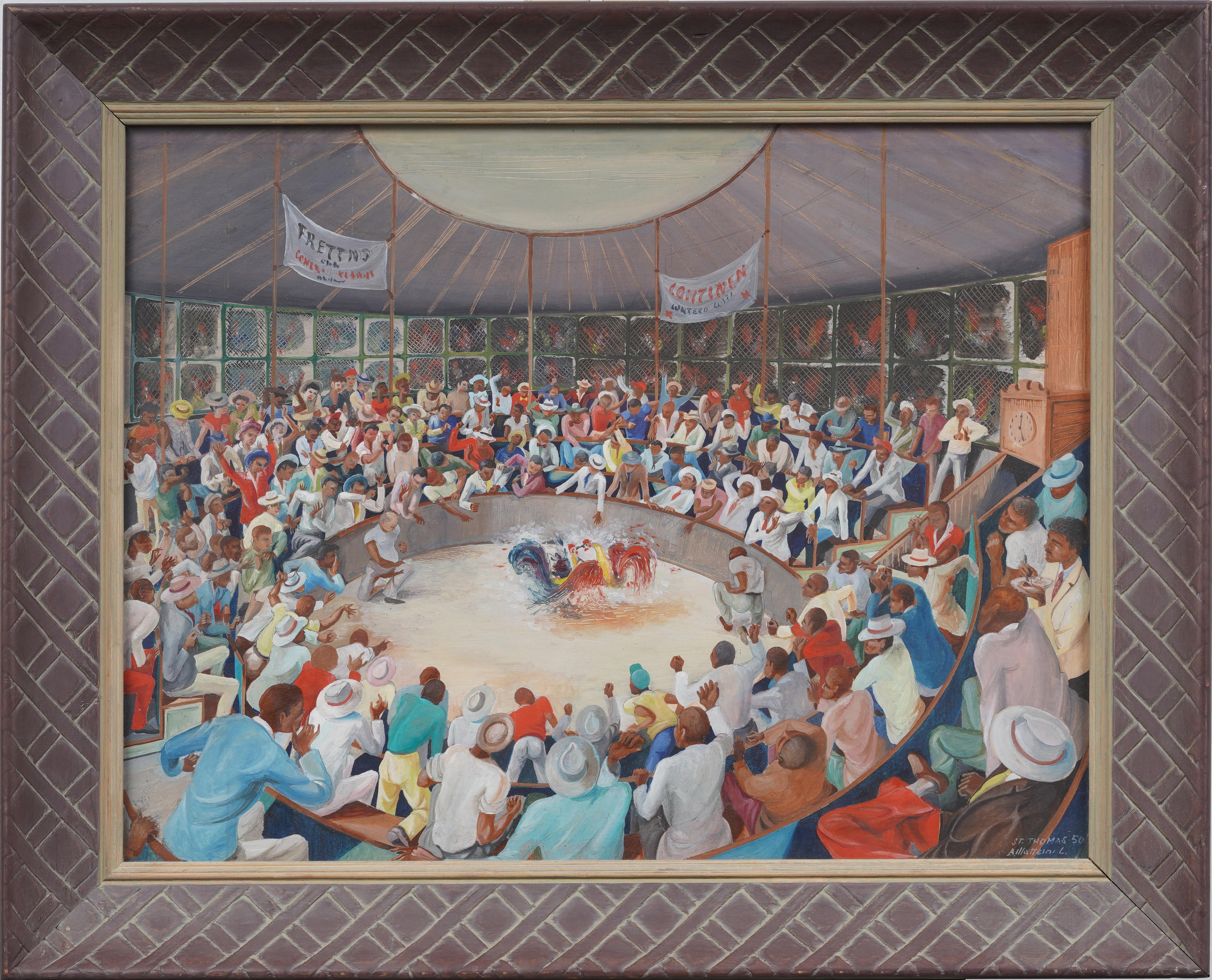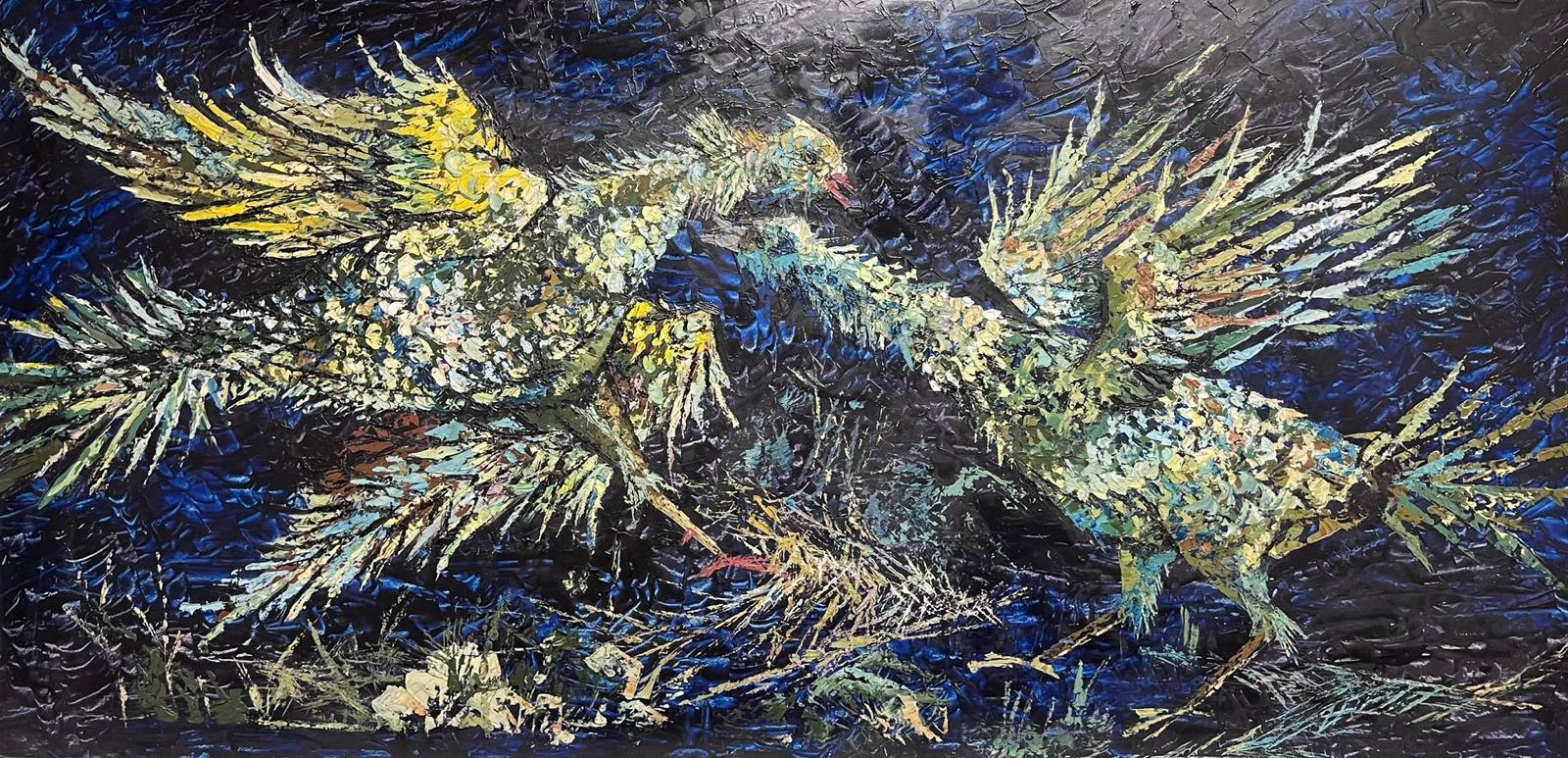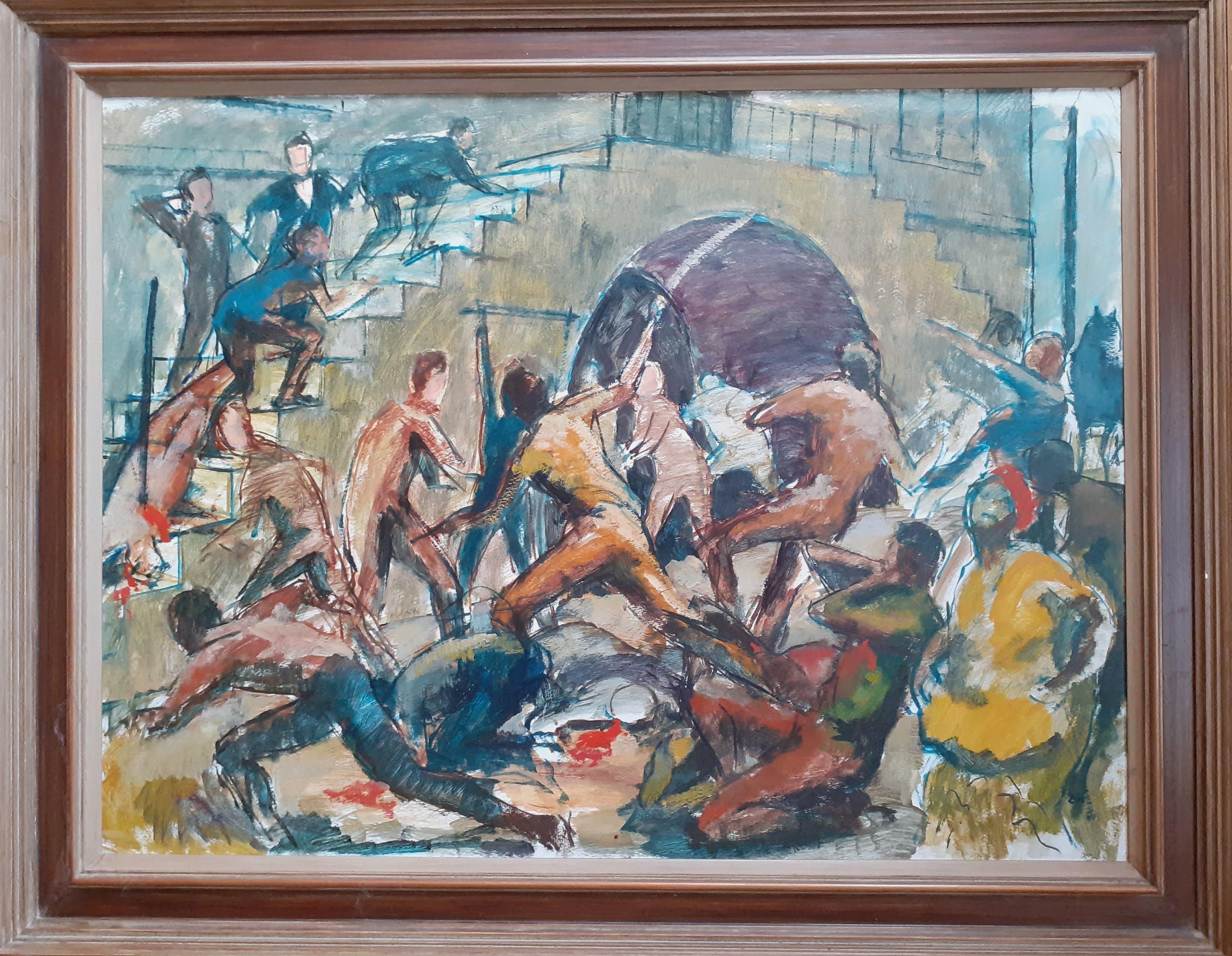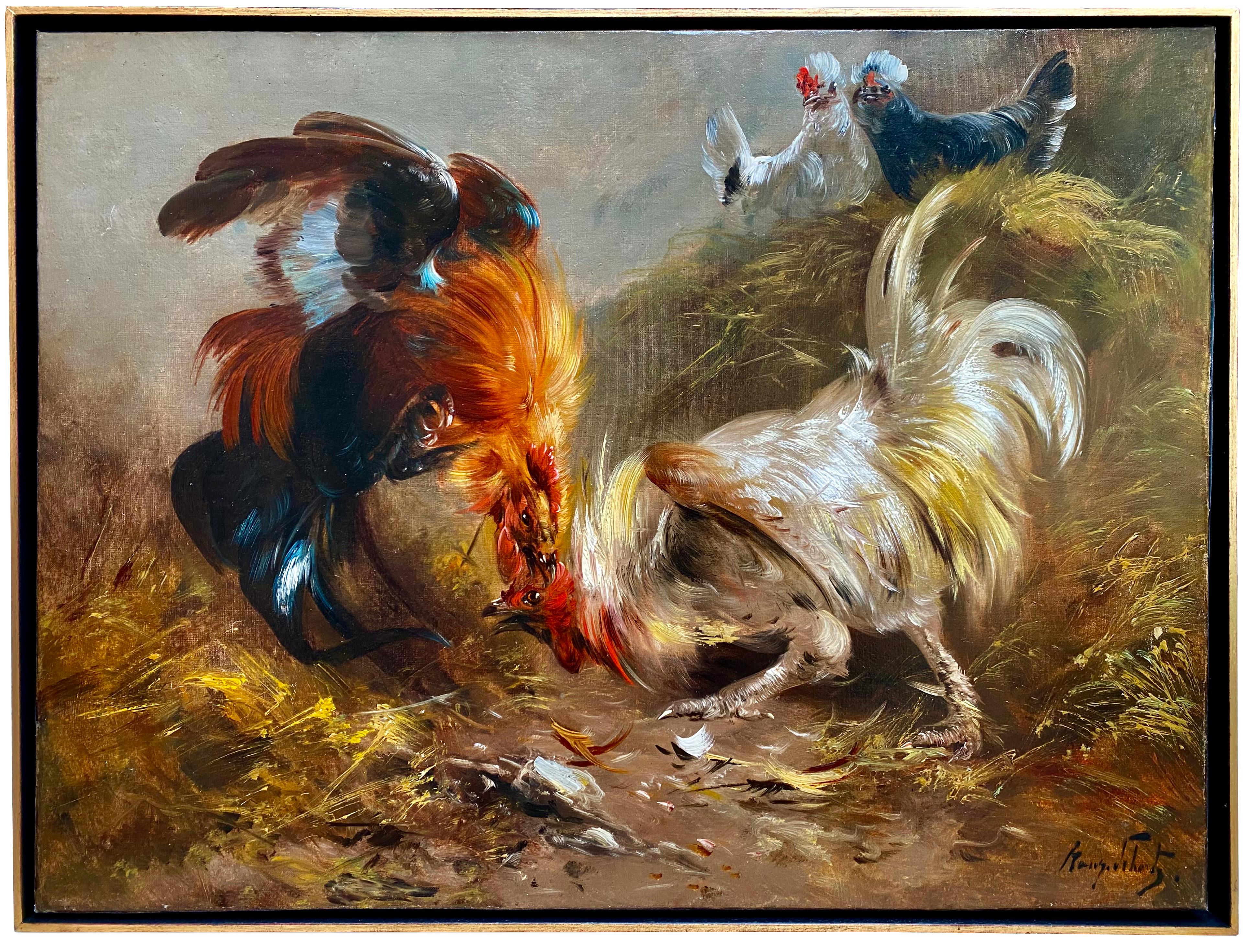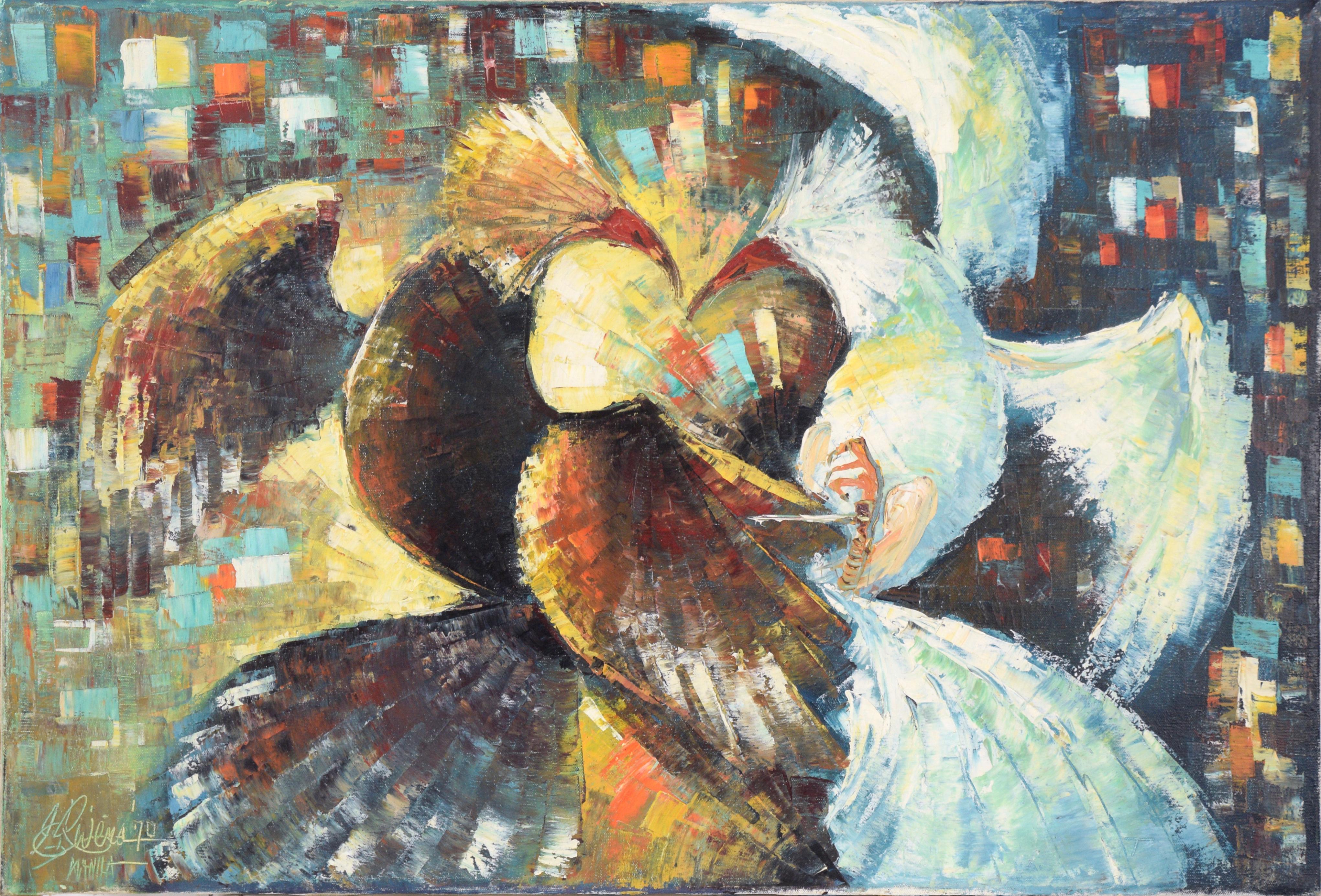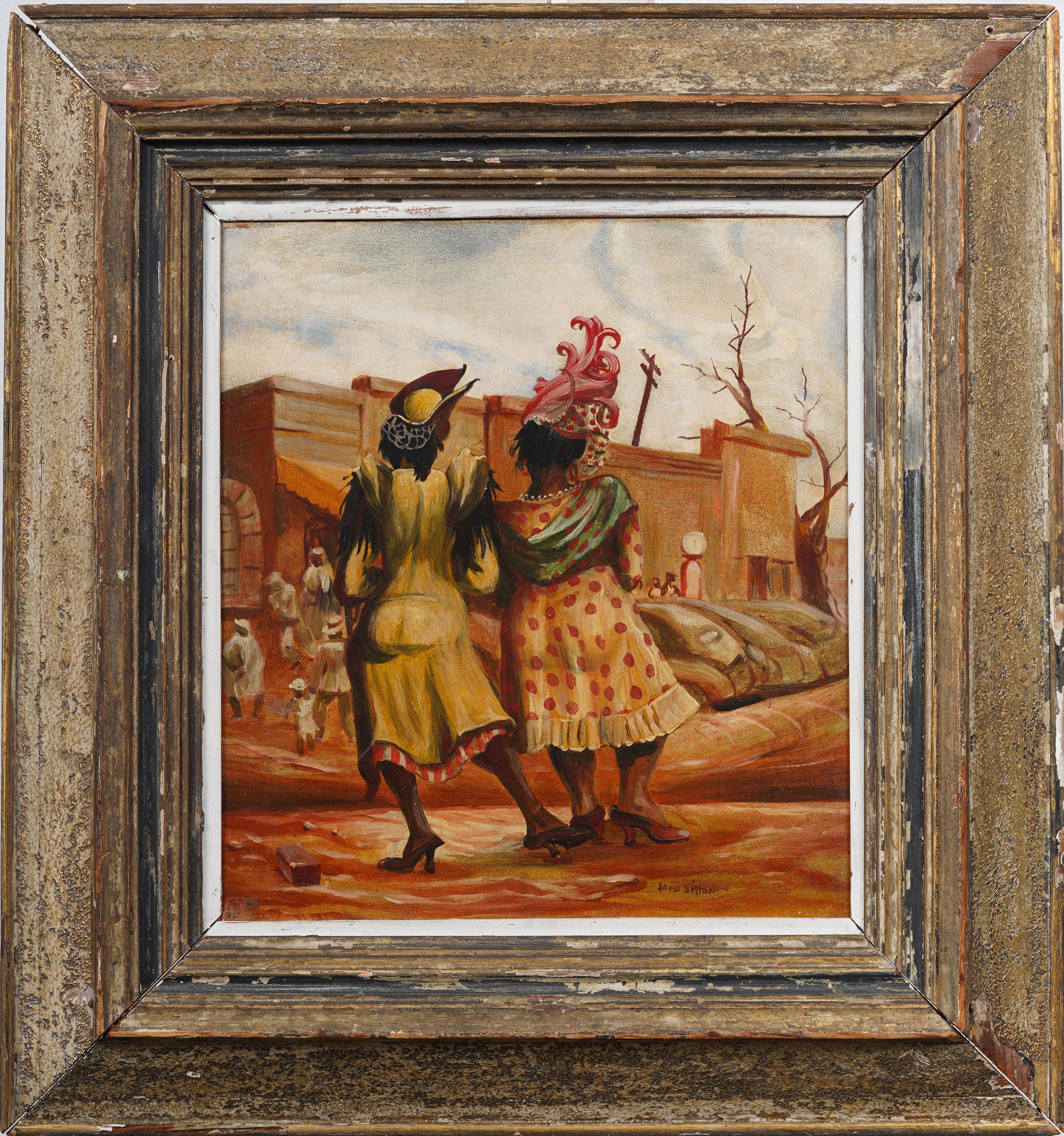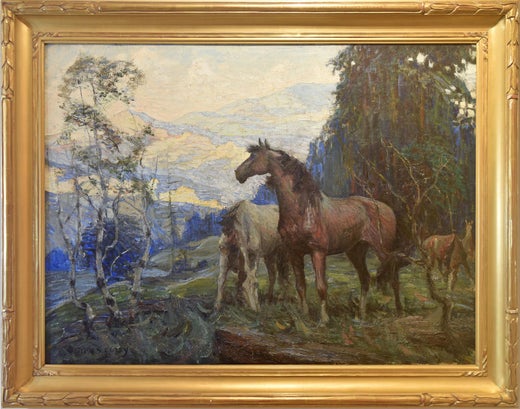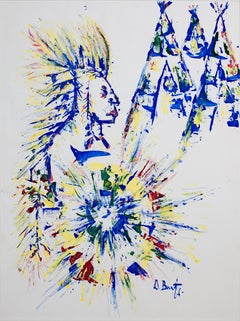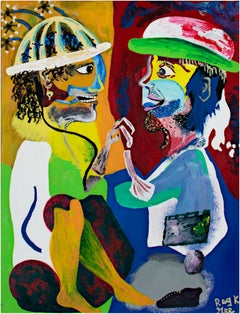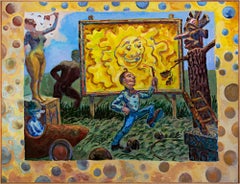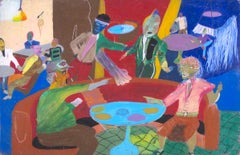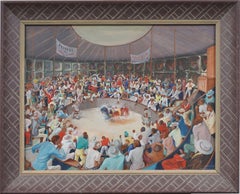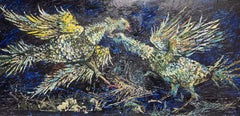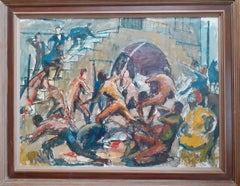Items Similar to 'Cock Fight in Cuba' original Regionalist painting signed by John Steuart Curry
Want more images or videos?
Request additional images or videos from the seller
1 of 10
John Steuart Curry'Cock Fight in Cuba' original Regionalist painting signed by John Steuart Curry1946
1946
$1,087,500
£821,236.57
€940,240.23
CA$1,535,834.27
A$1,676,763.38
CHF 879,058.44
MX$20,364,937.05
NOK 10,978,008.76
SEK 10,366,167.54
DKK 7,017,891.98
About the Item
John Steuart Curry
"Cockfight in Cuba," 1946
oil on canvas
Image: 38.25 x 46.25 in
Frame: 43.75 x 51.5 in
Signed on reverse with initials JSC on lower right stretcher bar
John Steuart Curry (1897-1946), is best-known as one of the American Regionalist artists active during the Great Depression through the World War II era. The Regionalists (including artists Grant Wood and Thomas Hart Benton) distinguished themselves from the abstract art scene during the first part of the Twentieth century by painting typically American subject matter, although Curry’s themes were hardly limited to farms. While born in Kansas on his family’s farm, Curry went on to study art in Chicago, Paris and New York as a young man. In Paris, he was exposed to the work of some of the Old Masters, particularly Rubens, Delacroix, and David. Like these artists, Curry’s major themes and subject matter were the great struggles of life.
One of Curry’s paintings that exemplify this theme of human struggle is Cock Fight in Cuba, which was completed in 1946, the year of his death. Curry spent a little over a month in Cuba in early 1946 in preparation for an advertising campaign for National City Bank, and undoubtedly sketched this scene, as was his method, while traveling in the country. The painting depicts a crowd of suited men in fedoras cheering on two fighting cocks in the foreground. While the men in the crowd gesticulate wildly behind a low wall indicating the barrier of the ring, three men are in the foreground of the painting, inside the ring with the roosters. The two on either side of the fighting animals have their arms extended out as if to hold the crowd back. The third man, in the lower right corner of the painting, is African and his hands reach towards the birds as if to save them, which has the effect of directing the viewer’s gaze at the action. Curry uses the lines created by the arm gestures of the men to bring focus on the drama of the fighting animals.
The colors with which Curry has painted Cockfight in Cuba are also a way that he directs the viewer’s attention and sets a mood for the piece. In the background of the painting, the crowd of men is painted en grisaille, or in shades of gray, which makes the dark brown skin of the African man in the foreground stand out. The bright red of the birds’ cockles and the blood on their feathers are about the only spots of color in the painting. This bit of contrast is very effective in drawing our gaze to the birds, who are themselves nearly a blur of flapping wings. Curry’s painting style in Cockfight is brushy, as if the way he applied the paint was also part of the rather frenzied, dramatic scene. This fact, along with the predominant use of gray in the background, probably led to the incorrect belief that this painting was unfinished at the time of Curry’s death, but we know it is a completed work because the artist’s conception is fully realized. The painting is also signed on reverse with the initials JSC on the lower right stretcher bar. More evidence of the finality of the painting can be found in the fact that preliminary drawings exist for Cockfight in Cuba that are in the collection of the Springfield Museum of Art in Missouri. The composition of the final painting directly reflects what the artist had worked out in the initial drawings.
The subject of fighting animals is one Curry used throughout his career, and most likely grew out of his experiences among animals in his youth on his parents’ farm. Curry witnessed the drama of life and death firsthand and this became to him a great allegory for human struggles. The image of two animals, even two of the same species, fighting to the death, was a symbol of humankind’s simultaneous innate violence and vulnerability.
The more specific symbolism in Cockfight in Cuba, however, is the comparison made by the artist between animal violence and the racial violence of Curry’s time. The horror of seeing the cocks fight to the death is a metaphor for white oppression of and the violence towards blacks in the United States at that time. It was during this era that highly publicized lynching was occurring in the South and America saw resurgence in the Ku Klux Klan. This painting is important because Curry has revealed for the viewer his own moral beliefs. Curry’s social and political views were progressive – he was a member of the National Urban League and was a civil rights activist, whose friends included Wisconsin Governor Robert Lafollette (founder of the Progressive party) and Lloyd Garrison, the famously liberal Dean of the University of Wisconsin Law School while Curry was employed at the University as artist-in-residence. Curry had made political statements in his paintings many times before and some of his most important works centered on subject matter from the African American experience during the early part of the Twentieth century. Examples include The Fugitive (lithograph, 1934-36) and Manhunt (lithograph, 1934), which are both about lynching, and what is arguably Curry’s most important work on this theme, The Freeing of the Slaves (mural, 1942, University of Wisconsin Law Library).
In Cockfight in Cuba, Curry was able to express deeply held beliefs on a subject that was important to him and many other people of his time. Curry believed that, above all, art should have a social significance to the viewer, and the best artists were those that presented current social or ethical issues in their work. By that standard, he would certainly have been pleased with this painting, which uses the event of the cockfight to create a spectacle analogous to horror of a lynch mob. This painting is a wonderful demonstration of how John Steuart Curry used scenes that he observed from life and re-interpreted them on canvas to express a greater moral meaning.
Essay by Monet C. Haskins and David J. Barnett
- Creator:John Steuart Curry (1897-1946, American)
- Creation Year:1946
- Dimensions:Height: 43.75 in (111.13 cm)Width: 51.5 in (130.81 cm)
- Medium:
- Movement & Style:
- Period:
- Condition:
- Gallery Location:Milwaukee, WI
- Reference Number:Seller: 12845g1stDibs: LU60535197151
John Steuart Curry
Born in Dunavant, Kansas on November 14, 1897, John Steuart Curry became the youngest member of the famed "Benton-Wood-Curry trio" of Regional Painters of the early 20th-century American Scene movement. He gained a national reputation for his rural Kansas scenes. The artist focused on people who were down-to-earth, plain spoken, and self-reliant, and who made a living through hard physical labor. Curry executed murals dealing with land settlement and racial justice, and his works reflecting these themes are in the Capitol Building in Kansas, the University of Wisconsin, the United States Department of the Interior, and the United States Department of Justice. The artist quit high school and attended the Kansas City Art Institute and School of Design. He transferred to the Art Institute of Chicago. Curry married Clara Derrick in 1923. He studied in Paris in 1927. He was not impressed by the modernist American painters, many of whom were adopting the 'isms' of French contemporary artists. Curry was determined to paint American subjects without European models and to celebrate patriotism, regional pride, and the common man. He settled in Westport, Connecticut. In 1928, he painted Baptism in Kansas. The painting was heralded nationally as work of a new American genre. It was exhibited at the Corcoran Gallery of Art biennial where it met critical acclaim. In 1931, Gertrude Vanderbilt Whitney bought it for her museum. Tornado over Kansas was unveiled in 1929 before the stock market crash and provided the city with the romance of man versus nature theme. In 1933, it received second prize at the Carnegie International Exhibit. In 1930, he had his first one-man exhibition at the Whitney Studio Club. His work of the 1930s contains themes of work, family, and land-- demonstrating the peace, struggle, and perseverance that Curry believed was the essence of American life. In 1934 he married Kathleen Shepard. The United States government selected him to paint murals for the Department of Justice and the Department of Interior. He was appointed Artist-in-Residence in the College of Agriculture at the University of Wisconsin in 1936. He was a member of the Art Students' League and won prizes including: Purchase prize, North West Print Maker, fifth annual Exhibition, 1933; second prize, Thirty-first International Exhibition, Carnegie Institute, 1933; gold medal, PAFA, 1941; prize, Artists for Victory Exhibition, the Metropolitan Museum of Art, 1941. Exhibitions include: “A Celebration of Rural America,” 2007, Danville Museum of Fine Arts and History; “Collective Images: the sketchbooks of John Steuart Curry, 2002, Worcester Art Museum; “Illusions of Eden: Visions of the American Heartland,” 2000, Columbus Museum of Art; “The American Century: Art and Culture 1900-2000,” Whitney Museum of American Art; and “John Steuart Curry: Inventing the Middle West,” 1998, M.H. de Young Memorial Museum. He died in Madison, Wisconsin in 1946.
About the Seller
4.9
Platinum Seller
Premium sellers with a 4.7+ rating and 24-hour response times
Established in 1966
1stDibs seller since 2017
447 sales on 1stDibs
Typical response time: 3 hours
- ShippingRetrieving quote...Shipping from: Milwaukee, WI
- Return Policy
Authenticity Guarantee
In the unlikely event there’s an issue with an item’s authenticity, contact us within 1 year for a full refund. DetailsMoney-Back Guarantee
If your item is not as described, is damaged in transit, or does not arrive, contact us within 7 days for a full refund. Details24-Hour Cancellation
You have a 24-hour grace period in which to reconsider your purchase, with no questions asked.Vetted Professional Sellers
Our world-class sellers must adhere to strict standards for service and quality, maintaining the integrity of our listings.Price-Match Guarantee
If you find that a seller listed the same item for a lower price elsewhere, we’ll match it.Trusted Global Delivery
Our best-in-class carrier network provides specialized shipping options worldwide, including custom delivery.More From This Seller
View All"Indian Pow-Wow, " Original Tempera Painting signed by David Barnett
By David Barnett
Located in Milwaukee, WI
"Indian Pow-Wow" is an original painting in tempera, signed in the lower right. It features gestural blue outlines, decorated in shades of yellow, blue, and green.
Art size: 24" x 1...
Category
1960s Contemporary Figurative Paintings
Materials
Tempera
"Footwork at Random - Variation I, " Mixed Media Acrylic signed by Reginald Gee
By Reginald K. Gee
Located in Milwaukee, WI
"Footwork at Random - Variation I" is a mixed media acrylic painting on canvas by Reginald K. Gee. The artist signed the artwork lower right. It depicts two figures dancing. Reggie K...
Category
Early 2000s Contemporary Figurative Paintings
Materials
Canvas, Mixed Media, Acrylic
"Artist In Heliopolis, " Acrylic on Canvas by Randall Berndt
By Randall Berndt
Located in Milwaukee, WI
"Artist in Heliopolis" is an original acrylic painting by Randall Berndt. It depicts a skipping artist with a few other distorted figures. "Heliopolis", in the title of the painting, may refer to the ancient Egyptian city.
50" x 64" canvas
Artist signature along top edge of back frame
Randall Berndt grew up on a farm near Markesan, Wisconsin, and holds an M.F.A. degree in painting from the University of Wisconsin-Madison. His work has been exhibited in many museum and gallery shows, both juried and invitational. These include, in recent years, the Butler Institute of American Art in Youngstown, Ohio (where he received the Juror's Choice Award), the Sioux City...
Category
1980s Figurative Paintings
Materials
Canvas, Acrylic
"Faraway from Familiar Sounds, " Oil Pastel Drawing signed by Reginald K. Gee
By Reginald K. Gee
Located in Milwaukee, WI
"Faraway From Familiar Sounds" is an original oil pastel drawing on ragboard by Reginald K. Gee. The artist signed the piece on the back. It depicts a number of abstracted figures se...
Category
1980s Contemporary Figurative Drawings and Watercolors
Materials
Oil Pastel
"El Baile (The Dance), " Oil on Jute signed by Ernesto Gutierrez
By Ernesto Gutierrez (b.1941)
Located in Milwaukee, WI
"El Baile (The Dance)" is an original oil painting on Jute by Ernesto Gutierrez. The artist signed the piece in the lower right. This painting depicts five figures dancing and playin...
Category
Early 2000s Figurative Paintings
Materials
Oil, Jute
"Saloon, " am Oil on Board signed by Charles Damrow
By Charles Damrow
Located in Milwaukee, WI
"Saloon" is an original oil painting on board signed and dated in the lower left by the artist Charles Damrow. It depicts two cowboys on horseback with guns aiming at the saloon as they ride away. There are bullet-holes in the window of the saloon building and the horse tied...
Category
1970s Other Art Style Figurative Paintings
Materials
Oil
You May Also Like
Antique Super Detailed Social Realist St Thomas Tropical Chicken Fight Painting
Located in Buffalo, NY
A vivid and densely populated cockfighting scene painted in 1950 and signed Allatteini L., lower right, with the inscription St. Thomas 50. This large-scale oil captures the spectacl...
Category
1950s Modern Interior Paintings
Materials
Oil, Board
1960's Huge Modernist Oil Painting The Cock Fight
Located in Cirencester, Gloucestershire
The Cock Fight
French School, circa 1960's period
oil on board, framed
framed: 25 x 48.75 inches
board: 24 x 48 inches
provenance: private collection
condition: very good and sound c...
Category
Mid-20th Century Modern Animal Paintings
Materials
Oil
$2,645 Sale Price
20% Off
Huge topical Black History slavery painting Jamaica Morant Bay 1865 rebellion
Located in Norwich, GB
Uprising - a huge and incredibly powerful and topical painting by Jamaican master painter Barrington Watson (1931-2016).
It depicts the 1865 Moran...
Category
1960s Realist Figurative Paintings
Materials
Masonite, Oil
'Cock Fight' by Henry Schouten (Batavia, Indonesia 1857 – 1927 Brussels)
Located in Knokke, BE
Henry Schouten
Batavia, Indonesia 1857 – 1927 Brussels
Belgian Painter
'Cock Fight'
A dynamic, vivid scene capturing two roosters mid-fight with Schouten’s signature fluid brushwo...
Category
Late 19th Century Impressionist Animal Paintings
Materials
Canvas, Oil
Abstract Rooster Fight Philippines 1970
Located in Soquel, CA
Bright and dynamic depiction of two birds fighting by Filipino artist JG Rivera (20th Century). Splashes of color surround a flourish of feathers. At the center of the composition, t...
Category
1970s Abstract Impressionist Figurative Paintings
Materials
Canvas, Oil
$1,500 Sale Price
20% Off
Antique American Modernist Forsyth Georgia Street Scene Southern Oil Painting
Located in Buffalo, NY
Antique American modernist street scene with two women. Rare oil painting by John Melza Sitton (Born 1907). Oil on canvas. Signed. Framed. In excellent original condition. Handsome...
Category
1940s Modern Portrait Paintings
Materials
Oil, Board
More Ways To Browse
Animals Fighting
Thomas Hart Benton Signed Lithograph
En Grisaille
Cock Fighting
Cockfighting Paintings
Glatz Oszkar
Graydon Parrish
Greek Mythology Oil Painting
Haitian Voodoo
Ingrid Smuling
Jack Hooper
Jon Demartin
Josep Serrasanta
Juan Soler
Kostabi On Canvas
Kristine Luize Avotina
Laurence Stephen Lowry
Linda Tracey Brandon
